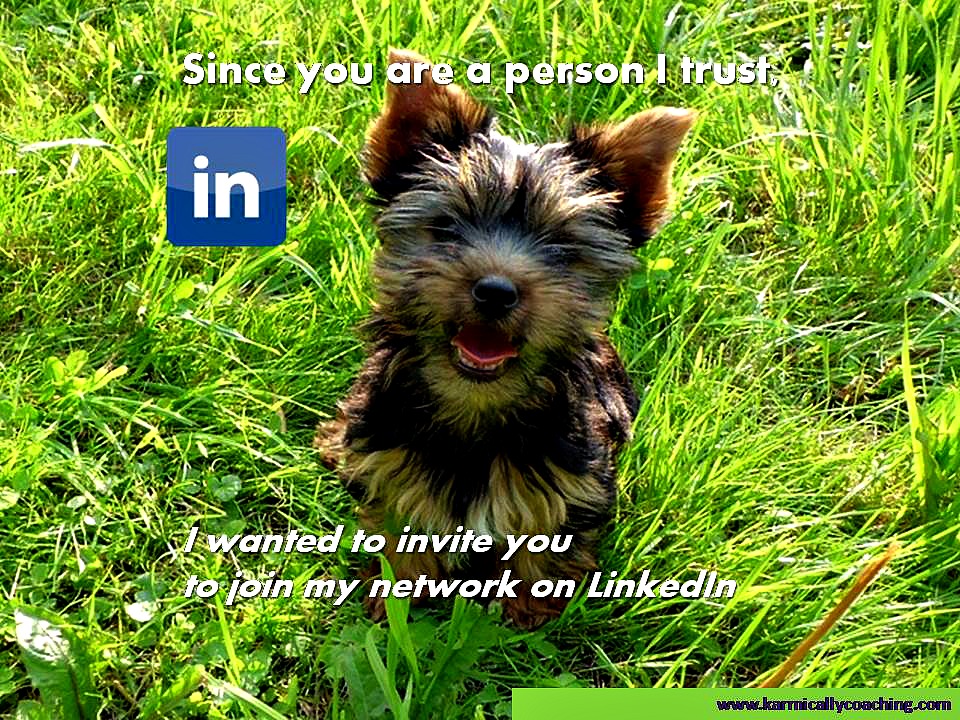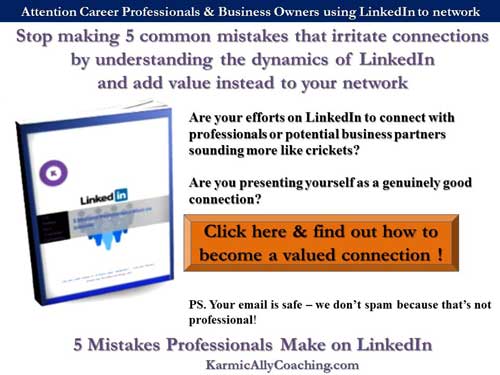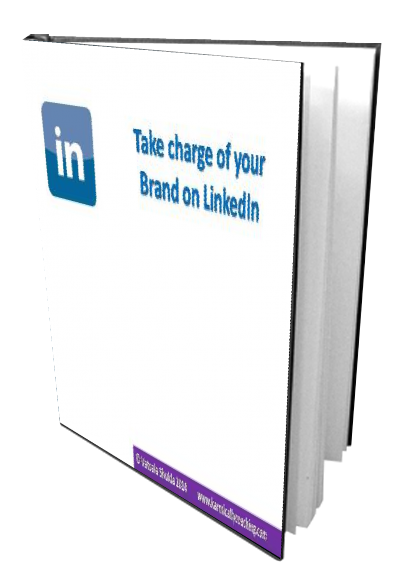This post has already been read 3667 times!

I wrote about connecting on LinkedIn sometime back in my blog post “Are You the Missing Link on LinkedIn?”.
It became so popular with spammers that my IT guy deleted all comments as a safeguard. Considering the spike in the number of trusting strangers wanting to connect with me in recent times, the topic merits a revisit.
Now, I am immune to the generic invitation
I’d like to add you to my professional network on LinkedIn
If I know the person, I accept the invitation immediately. Then I drop a line to them telling them how delighted I am to reconnect and catch up with what’s been happening.
I’ve updated my contact details on LinkedIn clearly stating how I can be contacted. If the person does not know me, they have to tell me the reason for wanting to connect & not pretend to be a friend.
Not that some people read the bottom of the LinkedIn profile or bother to honor my request. That’s okay. I’ll simply ask them to jog my ageing memory and remind me how we know each other.
Their reply decides my next course of action.
Since you are a person I trust, I wanted to invite you to join my network on LinkedIn
Imagine my surprise when I first received an invite with the above statement and could not place the person.
(Update October 2017: Since I wrote this post, this particular boiler plate template seems to have disappeared)
So, I logged in and went to look at the profile and found no picture, no details and 3 connections.
The only word that made sense was real estate and that too because as an IFRS specialist. I had done some work for real estate companies being listed on overseas stock exchanges.
Maybe this person is just starting out on this platform. Maybe we have worked together, and I made a good impression in real life.
Wanting to know more, I wrote back asking to be reminded how we knew each other. There was no response and I ignored the request.
You trust me enough to want to connect on LinkedIn but won’t answer a valid question?
Then I got another one where there was a picture of a beautiful model in great clothes.
This time my query resulted in a long message telling me about this apparel company and how they were exporting clothes to so many countries. I was instructed to immediately like their Facebook Page and promote them.
No second guessing, I declined the invitation and marked them as not knowing them. I couldn’t bring myself to mark them as spam but thought more about my reasons for declining these 2 invitations.
Here’s why I declined your invitation.
- I have no idea who you are
- We’ve never met in real life
- Your incomplete LinkedIn profile as the only reference point didn’t pass muster
- The profile shows we have no Group or mutual connection in common
- Your agenda is not clear (I don’t want to like you on Facebook or promote a strange stranger)
- My parents told me not to talk to strangers
- My dog doesn’t trust strangers and neither do I
What you should do instead to get your invitation to connect accepted
This holds true not only for me but others whom you trust but don’t know.
Once my irritation with the clothes horse subsided, I went searching on the platform. That’s when I discovered this being a trusted person is actually another default invitation template.
Nothing wrong with using it except that it makes me think that you are collecting connections, that you are not interested in real networking.
Using a template? Please personalize it!
Read the profile, find something or someone in common and let me know that you want to know me and not my name.
Take a minute to personalize it. I’m not obliged to accept your invitation. If you catch me on a bad day, I might just mark you as spam and if more people mark you as spam, LinkedIn may block you from trusting another stranger for a long time.
Quite possibly you may know the person from another social media platform like Twitter or Facebook Group. You may be in a LinkedIn Group, school alumni or visited their blog in which case mentioning this takes the sting out of the person I trust business.
It demonstrates that you are not a stranger, just someone who, for whatever reason selected a default template.
The stranger who made a difference
I got the “I trust you” invite from someone who had a photograph and the headline “looking for a job opportunity”. The profile was somewhat complete. We had 4 connections in common and I sent a communication asking how we knew each other.
To my pleasant surprise, I got an immediate reply that was honest, respectful and confirmed that we did not know each other. We were from the same professional background. She was looking for a job and hoped I could help her.
My heart melted. I’m a veteran of 3 economic recession-based redundancies. I know it takes courage to reach out and say that I need a job.
I gave her a few tips on how to improve her LinkedIn profile – things that I provide in my Build Your Brand on LinkedIn service gratis. She was grateful for the assistance which was implemented immediately. I was happy to have made a difference.
A few more to and fro by email with more suggestions for her job hunt and I accepted her invite. Knowing enough about her, made it easy to share her CV with my circle and ask if someone could help.
My point is, when you want to connect professionally with someone, be upright and honest.
Take the time to craft an invitation that shows you have put some thought into it.
Remember, in the online world, our terms of reference are very different.
You wouldn’t allow a stranger on the street into your home. Similarly, it stands to reason the same applies with someone online.
Have you been bombarded with the person I trust invitation by a stranger? How did you handle it? I’d love to know so please share your experience in the comments box below.
Need help to optimize your LinkedIn profile? Learn more by clicking the image below
Written by: Vatsala Shukla





 I adhere to the Certified Coaches Alliance Code of Ethics and Standards. A copy is available on request.
I adhere to the Certified Coaches Alliance Code of Ethics and Standards. A copy is available on request.
 Let's Talk through the Connect Form:
Let's Talk through the Connect Form:
“since you are a person I trust”
As of lately, It has been the lingo I am experiencing
Thanks for sharing your experience, John. I often wonder whether the professional using the template realizes that the receiver may start wondering how they have come to be a person of trust when they don’t know each other. 🙂
All valid points Vatsala. When I speak on the topic of LinkedIn, I stress the importance of starting a conversation. It’s important that folks stay away from generic’s LinkedIn invite and take the time to personalize their invitation (especially if they’re inviting someone they don’t know).
I also encourage people to not ignore invitations they receive, but to first visit the other person’s profile and if it appears to be someone you might want to connect with to then hit “Reply but don’t accept.” Sent the other person a request asking how they found you. If that person doesn’t reply then you can probably rest assured that they weren’t all that interesting in starting a conversation and building a relationship.
Thanks for sharing.
🙂
D
Thanks for sharing your insights and experience, Debra. The key to successfully using LinkedIn lies in engagement and creating relationships, not collecting virtual business cards. 🙂
I make it a point to visit all generic boiler invite profiles and as you pointed out, request more information. That is how example number 3 and I finally connected in the spirit of LinkedIn. In the cases where I do finally accept an invite, I usually write to thank them for reaching out to connect with me and offer the suggestion to personalize their invites for future engagement with others. So far, each one has written back in appreciation of my suggestion. Now that is conversation!
Yes – I’ve seen some of these invites on LinkedIn. Often they are from IT recruiters (which was my profession before I started out on my own).
I love your last example. Even though you didn’t know the person it sounds like you both used LinkedIn the way it’s meant to work. To connect with people in your network (and potentially to help each other out).
Thanks for sharing!
Sally
Welcome back, Sally. There seems to be an increase in such invites recently and it was my communication with the lady in the last example that reminded me that the other person may not be realizing the impact of the ‘trusting’ invite on the receiver. It is a good idea to ask how the other person knows you before accepting but the best action is to personalize the invitation to start with.
Vatsala, I’m visiting from Delia’s hood. Thanks for a top-flight article on reasonable caution with LinkedIn. As I am a stress management trainer, I had taken the advice of a social media expert to list myself as LION–a LinkedIn Open Networker. After all, who doesn’t need stress management training? However, I’m rethinking that LION designation now. What do you think?
I have not used LinkedIn very much, but I’m very interested in upshifting my efforts there, to find speaking/training opportunities.
Welcome to The Karmic Ally Coaching Experience Blog, Kebba. I’m glad you found the post useful. About being a LION, it all comes down to what your objective was when you listed yourself as a LION.
If the intention or objective was to grow your business, whether locally or globally, promote yourself via your status updates or to find people/prospects or business opportunities, then the decision to become a LION was a good one since you have made yourself available to more opportunity not to mention better search engine ranking and amplification of status updates and messages.
On the other hand, this also dilutes your network making it harder to comb through people you know in your list of connections. You might consider tagging your connections to make the filtering easier.
Simply connecting will not achieve one’s objectives and one has to engage meaningfully an aspect that I cover in my LinkedIn product for professionals.
Even as a LION, you retain control over who you wish to connect with. Remember you aren’t necessarily connecting with the person as much as you are connecting with their network and if their network is beneficial to you, you may wish to keep the person in your network.
If the request appears dubious or, as Graham Segal pointed out ‘iffy’, you are not obliged to accept that invitation. Connecting with someone on LinkedIn isn’t an endorsement of their character although in the case of non-LIONS who have an active off-line network; it may be misconstrued by others as a signal that you trust the person.
Hope that helps! 🙂
Vatsala,Thank you for such a down to earth and lucid post. I am a capital raise consultant so I attract a fair number of invitations to connect. There is a dark side to capital raising so I have to constantly keep my wits about me. When I receive an invitation that seems a bit 'iffy', I send back the following letter:Dear XXX,You have invited me to connect with you. I am wondering if you really understand that I am a capital raise consultant based in Australia. There does not seem to be much synergy or common ground between us. Perhaps you could explain in a little more detail how you think we may be able to help each other through a LinkedIn connection. I do not need access to expertise. I also note that you do not list investment or venture capital in your profile functions. For your information, the information that I regularly dispense to my LinkedIn connections relates to private placement investment opportunities with growth companies. In most cases, these documents are both sensitive and confidential. Consequently, I have a legal and professional responsibility to be aware of who receives these documents and to what purpose they may be put. In that regard, I am subject to a very strict set of government regulations. Governments the world over closely regulate the venture capital/securities industry. This is because there is a dark side to capital raising. The venture capital/securities industry, with its emphasis on financial deal making and the availability of persons often desperate to raise capital, is like a magnet for crooks, cheats, scammers and swindlers. These crooks, cheats, scammers and swindlers are the reviled cockroaches and rats of the venture capital industry and like their namesakes, they must be eliminated. Within the context of my foregoing comments, my LinkedIn connections are predominantly persons who are investors or people with a working relationship with the venture capital industry; viz., investors, business entrepreneurs and film producers. My role in the capital raise process is to ensure that my clients’ companies and projects are both investment ready and investor friendly. I then help my clients to find the capital required and take the company to market. Of course, if you are an investor in growth companies, or if you wish to seek capital to commercialise a unique product or simply to expand your company, then clearly we should connect. I am not trying to be negative or unkind here. I am just drawing attention to the facts of the situation. … end letter Vatsala, thank you bringing this matter to public attention.Sincerely, Graham
Looks like you have received quite a few of these vague invitations to connect on LinkedIn, Graham! Coming from an audit background myself, I tend to be cautious while connecting as well. The venture capital market is very different and your requirement to keep your connections ‘clean’ is very important. I’m curious though, do any of these ‘iffy’ connection requests ever respond back or do they disappear back into the black hole? 🙂
Interesting read Vatsala, I have a Linkedin profile that I really must update as I too have recently experienced economic based redundancy.
Welcome to The Karmic Ally Coaching Experience Blog, Lyn! Sorry to read about your redundancy. Updating your LinkedIn profile is an excellent idea. I suggest that you update your Curriculum Vitae first and then use it as a base for the LinkedIn update so that both are synchronized. Start networking both offline and online. You never know who knows someone who really needs your expertise at this very moment. All the best!